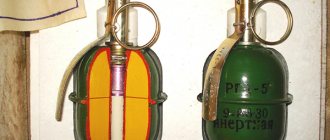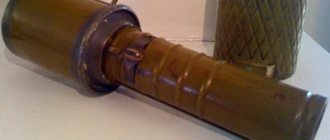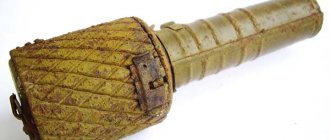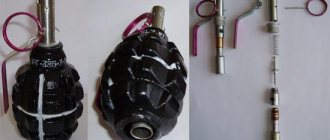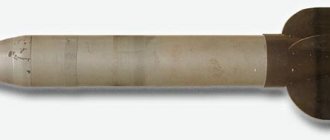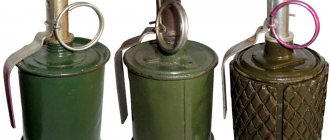The online store “Derzhava” has been successfully operating in the field of sales of military and army paraphernalia for a long time. One of the product categories that is in high demand among our customers is imitation projectiles. Their parameters are as close as possible to their combat counterparts, they correspond to them in weight, configuration and structural elements, but are used for production and training purposes. Whatever you need - airsoft, paintball, training and simulation grenade, we can ensure the supply of goods in the required volume.
Training hand grenades
97. Educational and training hand grenades are used for initial training in loading grenades, studying the rules of handling them, learning the techniques of throwing them, as well as during training in order to develop skills in throwing grenades from various positions when operating on foot and on armored personnel carriers (infantry fighting vehicles).
In combat training of military personnel, the RG-42, RGD-5, F-1 hand fragmentation grenades (Fig. 88) and the RKG-ZE anti-tank hand grenade are used.
Training hand grenades should not differ in shape and weight from combat hand grenades.
Rice. 88. Training hand fragmentation grenades:
1 – RG-42: 2 – RGD-5; 3 – F-1
Each training hand grenade is a specially made blank (Fig. 89), the body of which, instead of an explosive charge, is filled to the required weight with sand or scraps of metal.
Rice. 89. Parts of the F-1 training hand fragmentation grenade:
1 - blank; 1 - imitation fuse; 3 - fuse; 4 — trigger lever; 5 - ring
The imitation fuse is made of wood or metal, and the safety pin, trigger lever and ring correspond to the shape and size of a combat grenade.
Training grenades are painted black, and the letters “Uch” are printed on the side surface of their body.
Training in loading and throwing grenades is carried out in accordance with the Shooting Manual “Hand Grenades”.
After throwing a training grenade, the parts that fall out of it must be picked up and assembled on the grenade for the next throw.
F-1 grenade
F-1 - hand-held anti-personnel defensive grenade. (GRAU index - 57-G-721)
Designed to defeat manpower in defensive combat. Due to the significant radius of scattering of fragments, it can only be thrown from behind cover, from an armored personnel carrier or from a tank.
Characteristics of the F-1 grenade
Diameter, mm: 55; Case height, mm: 86; Height with fuse, mm: 117; Grenade weight, kg: 0.6; Explosive mass, kg: 0.06-0.09; Explosive type: TNT; Fuse: UZRGM; Deceleration time, sec: 3.2-4.2; Throwing range: 35-40 m; Shrapnel damage radius: 50 m /// 200 m - safe distance; Fuse deceleration time: 3.2-4.5 sec; Number of fragments: up to 300 pcs.
The F-1 grenade is a hand-held anti-personnel, long-range defensive fragmentation grenade. Its design turned out to be so successful that it has existed to this day without fundamental changes. The design of the fuse was slightly changed and modified in order to increase operational reliability.
Manual - delivered to the target by throwing the soldier’s hand.
Anti-personnel - designed to destroy enemy personnel.
Fragmentation - damage is caused mainly by fragments of the metal body of the grenade.
Defensive - the radius of scattering of fragments exceeds the average range of throwing a grenade using the muscle strength of a fighter, which necessitates the need to throw a grenade from cover in order to avoid being hit by fragments of one’s own grenade.
Remote action - the grenade detonates some time after the throw (3.2...4.2 s).
Application of F-1
To use a grenade, you need to straighten the antennae of the safety pin, take the grenade in your right hand so that your fingers press the lever to the body. Before throwing a grenade, insert the index finger of your left hand into the pin ring and pull it out. The grenade can continue to remain in the hand for as long as desired until the lever is released, the firing pin cannot break the primer (in principle, if the need to throw a grenade has disappeared and the pin has not been thrown out, it can be inserted back (without releasing the lever!); after bending tendrils of pomegranate pins are suitable for normal storage). After choosing the moment of the throw and the target, throw a grenade at the target. At this moment, the lever will rotate under the influence of the striker spring, releasing the striker, and fly off to the side. The drummer will puncture the capsule and after 3.2 - 4.2 seconds an explosion will occur.
The grenade is designed to destroy manpower and unarmored vehicles. The damaging factors are the direct high-explosive action of the explosive and the fragments formed when the metal shell of the grenade is destroyed.
Also, F-1 grenades are often used when setting tripwires, this is due to the number of fragments, which increases the chances of hitting the enemy, and a reliable fuse, which will not be damaged by prolonged exposure to unfavorable conditions before the trap is triggered.
A combination of 2 F-1 grenades creates a tripwire, which also has some anti-sapper properties - it explodes when the cable (wire) is cut. In special forces, the F-1 grenade is “modified”; before installation as a trip wire, the detonating charge is cut off and the fuse is removed. Or they install an instant mine fuse of suitable size. Thus, they achieve an almost instantaneous explosion and deprive the enemy of 3.2 - 4.5 seconds. for salvation.
Training and simulation hand grenades
98. Training and simulation hand grenades (Fig. 90) are used, as a rule, to perform exercises provided for in the shooting course, as well as for grenade throwing during combat firing within units.
The following training and simulation hand grenades are used in combat training of military personnel: URG-N (training offensive hand grenade); URG (training defensive hand grenade); UPG-8 (training anti-tank grenade).
Training and simulation hand grenades do not differ from combat grenades in shape, weight and handling rules. When falling, they simulate rupture with sound and smoke effects.
Training and simulation grenades can be used repeatedly.
Rice. 90. General view of training and simulation hand grenades:
1 – URG-N; 2 – URG: 3 – UPG-8
Training and simulation grenades URG-N and URG
99. The training and simulation grenade URG-N (URG) consists of a body and a simulated fuse.
The body of the URG-N grenade is the body of the RGD-5 hand fragmentation grenade, and the URG grenades are the body of the F-1 hand fragmentation grenade. A hole was made in the bottom of the body to enhance the sound effect during the explosion of a simulated salvo and to allow the release of powder gases.
To distinguish it from combat hand grenades, the body of training-imitation hand grenades is painted black and marked, and the body of the URG, in addition, has transverse and longitudinal white stripes.
The imitation fuse (Fig. 91) consists of an impact mechanism, an adapter sleeve and an imitation part.
Rice. 91. Imitation fuse:
a – assembled; b – disassembled; 1 – impact mechanism; 2 – safety pin ring;
3 – adapter sleeve; 4 – imitation part; 5 – release lever
The impact mechanism is designed in the same way as the impact mechanism of the UZRGM fuse; The only difference is that it has a longer striker.
The adapter sleeve connects the impact mechanism with the imitation part and protects it from contamination and damage by powder gases.
The imitation part of the fuse (Fig. 92) is used to obtain the sound and smoke effect of a combat grenade exploding. It consists of the same parts as the UZRGM fuse itself, only instead of a detonator capsule, a more elongated sleeve with a black powder charge is tightly put on the moderator sleeve.
Rice. 92. Imitation part of the fuse (sectional view):
1 — igniter primer; 2 — retarder bushing; 3 - moderator; 4 - black powder; 5 - sleeve; 6 — wad
To reload the imitation fuse, a mandrel is used (Fig. 93), which is provided for every four grenades.
Rice. 93. Mandrel for reloading an imitation fuse:
1 — channel for the striker; 2 - hole
How did the legendary “lemon” appear?
The military was immediately able to appreciate the advantages that hand grenades had. Used as hand-fired anti-personnel ammunition, grenades radically changed close combat tactics. The shrapnel, which is the main destructive element of these munitions, could instantly incapacitate a large group of people. This detail was very convenient for conducting defensive actions when it was urgently necessary to stop an enemy attack. In the Soviet Union, such ammunition was taken very seriously. The reserves of hand grenades, inherited by the Red Army from the tsarist army, were exhausted during the Civil War. The infantry units of the Red Army were in dire need of increasing the combat effectiveness of their fighters through hand-held fire weapons.
Frag grenades
Faced with a shortage of hand grenades during the suppression of the Basmachi movement in Central Asia, in the mid-20s, on instructions from the Revolutionary Military Council, Soviet gunsmiths began developing new types of hand grenades. Two options for ammunition were considered at once - for offensive purposes and for defense. Already in 1926, the designer Dyakonov presented his development, a hand-held defensive-offensive grenade, to the high military commission. The finished sample received the index RGD-33 and was adopted by the Red Army. The defensive option was handled differently. Soviet designers did not reinvent the wheel. The French F-1 fragmentation hand grenade of the 1915 model was taken as the basis. It was this ammunition that the commanders and Red Army soldiers who had gone through the crucible of the fronts of the First World War and the Civil War were very familiar with.
Soviet gunsmith engineers, under the leadership of military engineer Khrameev, had to carry out an almost complete modernization of the ammunition. The original model was released in 1939 and was called and received the index F-1. The design of the F 1 fragmentation hand grenade differed from the French-made product. The main emphasis was placed on the perfection of the fuse, which the French grenade had a shock action. Such a mechanism for putting into action in modern conditions has become extremely dangerous and not always convenient. Not always during a fight does a fighter have the opportunity to make a throw. The grenade designers were faced with the task of creating a controlled fuse. The grenade must be activated after a certain time without mechanical contact of the body with an obstacle. A way out of the situation was suggested by engineer Koveshnikov, who managed to create a simple and reliable fuse.
Fuse
The grenade was intended to destroy manpower. The main damaging element was body fragments that were formed during the explosion of the explosive charge. For this purpose, the designers created a cast iron body, artificially divided into ribs. The ammunition was activated using manual manipulation. The Koveshnikov fuse provided the remote action of the F-1 grenade. In other words, the detonation of the ammunition charge occurred with a time delay of 5-6 seconds. The lemon exploded regardless of whether it was thrown at the target or continued to be in the hands of the fighter. A distinctive feature of a defensive-type hand-held fragmentation grenade was that the fragments scattered over a distance exceeding the throwing range, so such a weapon required special knowledge and skills during combat use.
The operation of the parts and mechanisms of the imitation fuse is similar to the operation of the UZRGM fuse
When handling and throwing training simulation grenades, you must follow the rules for combat grenades.
Before placing a grenade in a grenade bag, you should inspect the body and parts of the fuse, and then assemble the fuse, for which the imitation part is attached (screwed in) to the firing mechanism.
To throw a grenade again, you need to unscrew the fired fuse from the grenade body; take the fuse in your left hand and unscrew the imitation part; unscrew the adapter sleeve, being careful not to lose the mainspring and washer; take a new firing pin, insert it with its tip into the hole in the mandrel, put a washer and mainspring on top of the firing pin; insert the assembled parts together with the mandrel into the channel of the impact mechanism until the striker head comes through the hole in the guide washer; Without releasing the mandrel, insert the release lever with a fork into the groove of the striker head and press it against the tube of the striker mechanism; insert a safety pin into the holes of the lever and tube and separate its ends; remove the mandrel, screw in the adapter sleeve and a new imitation part of the fuse.
After 5-7 throws of a training-imitation grenade, it is necessary to clean the hole for the passage of the striker in the adapter sleeve of the fuse from carbon deposits.
